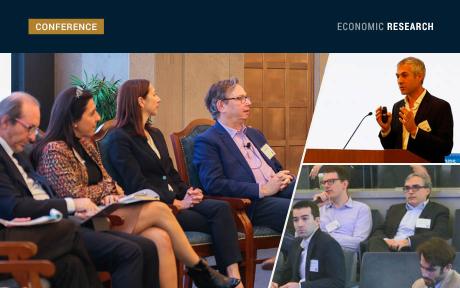
The COVID-19 pandemic, geopolitical tensions, and distinct economic conditions bring challenges to economies worldwide. These key themes provided a backdrop for the fifth bi-annual Global Research Forum on International Macroeconomics and Finance, organized by the European Central Bank (ECB), the Federal Reserve Board, and Federal Reserve Bank of New York in New York in November. The papers and discussions framed important issues related to the global economy and financial markets, and explored the implications of policies that central banks and other official sector bodies take to address geopolitical developments and conditions affecting growth, inflation, and financial stability. A distinguished panel of experts shared diverse perspectives on the drivers of and prospects for inflation from a global perspective. In this post, we discuss highlights of the conference. The event page includes links to videos for each session.
Exchange Rate Movements Reflect a Broad Range of Forces
Exchange rates are the measure of the price of a domestic currency, relative to a foreign currency or a basket of currencies. This price adjusts quickly to changing current and expected future conditions, and sometimes is misinterpreted by observers. An example has been recent movements in the Russian ruble exchange rate, which has gyrated dramatically since the invasion of Ukraine and through rounds of economic and financial sanctions. Oleg Itskhoki (UCLA), presented on “Sanctions and the Exchange Rate,” arguing forcefully that the effectiveness of sanctions cannot be inferred from exchange rate dynamics. His work further explains that the direction of exchange rate movements depends on the balance between currency demand and currency supply forces in response to different types of sanctions imposed. In turn, these depend on the relative strength of the import sanctions—which generate an appreciation of the country’s exchange rate as demand for foreign goods declines—versus export sanctions, increased precautionary household demand for foreign currency, and financial sanctions. Each of the latter channels generates a depreciation of the currency by restricting the availability of foreign currency relative to domestic currency in local markets.
More generally, a debate considers the relative importance of so-called fundamental drivers of the exchange rates and forces associated more with financial conditions. Rosen Valchev (Boston College), who shared new work in “Exchange Rate Disconnect Redux,” argues that variation in expected U.S. total factor productivity (TFP) explains more than half of exchange rate fluctuations across a set of industrial countries vis-à-vis the U.S. dollar. Consistent with some of the prior literature about the role of expectations of fundamentals, Valchev’s novel results are such that differences in anticipated versus realized TFP generate a wedge between movements in the exchange rates and current macro fundamentals.
The stance of monetary policy across economies also contributes to exchange rate dynamics. Presenting “Monetary Policy during Unbalanced Global Recoveries,” Federica Romei (University of Oxford) showed that higher tradable goods inflation in the one country (caused, for example, by a relocation shock) transmits across the border via capital flows. A non-cooperative monetary policy leads to “reverse currency wars” where countries try to appreciate their exchange rates vis-à-vis the other country and run trade deficits, leading interest rates and unemployment to be too high relative to the social optimum that could be achieved from international cooperation in setting monetary policy.
The U.S. dollar exchange rate closely tracks changes in global risk appetite, driven by “flight to safety” at times of increased risk aversion of global investors. But an important open question in the literature is to disentangle quantitatively the relative importance of different channels (the trade channel versus the financial channel) through which fluctuations in the U.S. dollar exchange rate shape cross-border transmission of risk aversion shocks. Georgios Georgiadis (ECB), sharing analysis described in “Global Risk and the Dollar,” estimated dynamic effects of risk aversion shocks on the global economic activity using a Bayesian Vector Autoregressive Model, finding these shocks induce an appreciation of the U.S. dollar and a global recession. In a counterfactual world in which the U.S. dollar did not respond to risk aversion shocks, the decline in foreign GDP growth would have been significantly less. Georgiadis concludes that adverse effects of U.S. dollar appreciations on foreign economies through the financial channel dominate the positive effects through the trade channel by boosting foreign countries’ exports.
Ambrogio Cesa-Bianchi (Bank of England) presenting work undertaken with coauthor Fernando Eguren-Martin in “Dash for Dollars,” uses within-firm corporate bond spreads data to show that U.S. dollar-denominated bonds experienced larger increases in spreads relative to non-dollar bonds around the COVID-19 outbreak, especially at short maturities. This empirical regularity cannot be explained solely by a liquidity-driven dash for cash, they find. Instead, investors tend to sell their dollar-denominated assets first to match the currency of denomination of their obligations, especially in the states of the world in which the cost of hedging foreign exchange risk is high.
International investors’ behavior also drives capital flows as economies are hit by shocks. Andrea Gazzani (Bank of Italy), addressed the topic in a coauthored piece entitled “Flight to Climatic Safety: Local Natural Disasters and Global Portfolio Reallocation,” finding evidence that suggests natural disasters reduce capital inflows in affected countries, driven largely by reallocation of flows from affected economies to advanced economies as investors look for climatic safety after a disaster.
International Trade and Financial System Environments Are Intertwined
The debates about policy effects and international cooperation also extend to tools applied to trade and capital flows. For example, cross-border trade integration has non-negligible consequences for countries’ decisions on opening the economy to international capital markets. Simon Lloyd (Bank of England) highlighted the conditions under which optimal capital controls are affected by restrictions on international trade, as captured in “Capital Controls and Free-Trade Agreements.” He found that domestic welfare outcomes depend on whether the domestic policymaker acts unilaterally or in cooperation with the rest of the world, and with interdependencies between the effects of capital controls and trade protectionism.
International trade restrictions can lead to real economic effects even when these restrictions are threatened but not yet implemented. Some of these consequences arise due to trade policy uncertainty leading to contractions in the supply of loans through banks. Using the 2018-19 “trade war” uncertainty and U.S. bank-lending data, Ricardo Correa (Federal Reserve Board of Governors) with Julian Di Giovanni and Linda Goldberg, presenting in “Trade Uncertainty and U.S. Bank Lending,” showed that U.S. banks that were more exposed to firms hit by larger trade uncertainty contracted credit to a greater degree than other banks. As this contraction in credit was to all borrowers—even if to different degrees—trade uncertainty is interpreted as having a pernicious effect on overall bank lending. Examining several layers of heterogeneity, the paper shows that banks that specialize more in lending to foreign borrowers, in trade credit or investment loans, contract credit supply more. On the receiving side, the firms that are more dependent on intermediate-goods imports for production experience the strongest tightening of credit availability. Thus, fragmentation in international trade can spill over to the financial sector.
Hedging activities can reduce some of the real consequences of exchange rate changes for firms, as exchange rate changes revalue firms’ revenues, costs, assets, and liabilities. Patrick Adams (MIT Sloan), shared work with coauthors on “Exchange Rate Risk in Public Firms,” measuring the net effects and considers the extent to which firms hedge their exposure to FX risk. Using data for a large cross section of firms and countries, the authors show that firms’ profits react to exchange rates, and that overall FX transaction income passes through strongly to firms’ final profits, with stock returns likewise responding. This behavior implies limits on the operational hedging of FX transaction risk, and real consequences of exchange rates at the firm level.
In “The Dominant Currency Financing Channel of External Adjustment,” Yannick Timmer (International Monetary Fund) revisits a classic question in international macroeconomics: how does an exchange rate depreciation impact the trade balance given expenditure switching (that is, via a rise in exports and a fall in imports)? To inform this issue, he first builds a model where there is “dominant currency financing” so firms borrow in U.S. dollars rather than local currency, meaning that a depreciation increases a firm’s debt burden and cost of financing. This dynamic leads to a depreciation driving trade fluctuations via reductions in net worth, generating downward pressures on both exports and imports, so that the effect on a country’s trade balance is theoretically ambiguous. The author finds support for the model’s main predictions using Colombian firms’ debt and examining a large-scale depreciation driven by 2014 oil price shock.
The Drivers and Prospects for Inflation in the International Context
A conference highlight was the sharing of perspectives on inflation’s drivers and prospects by a distinguished panel of experts, providing very different opinions as their areas of expertise also are distinct. Panelists were Elaine Buckberg (General Motors), Matteo Ciccarelli (ECB), Mark Gertler (New York University), Steve Kamin (American Enterprise Institute), and Ṣebnem Kalemli-Özcan (University of Maryland), with Linda Goldberg (Federal Reserve Bank of New York) as moderator.
Gertler emphasized macroeconomic conditions as a factor in inflation, including the evolving relationship between current and potential GDP as demand shifted during the pandemic, and the dynamics of prices of core and imported goods, oil and food, as well as the dynamics of wages. He also highlighted the importance of global supply-side factors in driving the core-goods prices in the United States after the pandemic. Other panelists strongly emphasized supply-side factors, in particular disruptions to the global supply chain and oil price shocks, as key drivers of recent global inflation, amplified significantly through boosted demand stemming from the pandemic stimulus. Kalemli-Özcan argued that a global health shock combined with limited substitutability across productive inputs on the supply side accounted for the majority of inflation. Buckberg observed that, from an industry perspective, lessons learned are being reflected in investments to reduce some of the concentrated dependencies on particular suppliers, for example, in the production of very specialized chip inputs, to establish sustainable raw materials supply for future robustness.
Dialogue also focused on the recent appreciation of the U.S. dollar as being one of the important channels through which U.S. monetary policy tightening can cool the U.S. economy, with additional attention on the synchronous nature of the current monetary tightening cycle across both advanced and emerging market economies. Kamin argued that the Federal Reserve’s response to soaring inflation has been in line with international norms, with a weak observed relationship between country increases in core inflation and their bilateral exchange-rate movements against the U.S. dollar.
What is more, climate policies were noted as mattering for the inflation outlook, with Ciccarelli providing an assessment that how these impact inflation ends up being quite uncertain. Arguments could be made that climate policies do not necessarily hamper price stability, especially when households’ expectations and country-level heterogeneity are taken into consideration. Further, a given type of climate policy—whether non-market-based (such as around technology support) or market-based—will affect prices differently through effects on energy demand and energy supply. Participants noted that, looking ahead, these longer-run considerations will be on policy agendas well beyond the period of economic recovery and stabilization following the COVID-19 pandemic.

Ozge Akinci is a research economist in International Studies in the Federal Reserve Bank of New York’s Research and Statistics Group.

Julian di Giovanni is the head of Climate Risk Studies in the Federal Reserve Bank of New York’s Research and Statistics Group.

Linda S. Goldberg is a financial research advisor for Financial Intermediation Policy Research in the Federal Reserve Bank of New York’s Research and Statistics Group.
How to cite this post:
Ozge Akinci, Julian di Giovanni, and Linda S. Goldberg, “Highlights from the Fifth Bi‑annual Global Research Forum on International Macroeconomics and Finance,” Federal Reserve Bank of New York Liberty Street Economics, December 19, 2022, https://libertystreeteconomics.newyorkfed.org/2022/12/highlights-from-the-fifth-bi-annual-global-research-forum-on-international-macroeconomics-and-finance/
BibTeX: View |
Disclaimer
The views expressed in this post are those of the author(s) and do not necessarily reflect the position of the Federal Reserve Bank of New York or the Federal Reserve System. Any errors or omissions are the responsibility of the author(s).













 RSS Feed
RSS Feed Follow Liberty Street Economics
Follow Liberty Street Economics